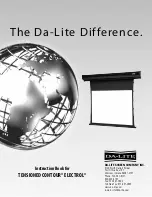
HCT User Guide
page 15
Copyright © 2001 HutchColor, LLC
User_Guide_43.docx 2/10/19
Pseudo-chrome profiles
The following method can be used to make an excellent scanner profile for any film type for which
there is no available HCT target. This is commonly the case for older emulsions that are no longer
manufactured. Provided you have some representative examples of the film type in question, a good
eye for color, and a lot of patience, you can edit any Ektachrome
®
or Fujichrome
®
HCT profile to
reproduce that emulsion with remarkably accurate results.
Note that this process is relatively non-scientific, relying on visual judgment rather than physical
measurements. If you are not comfortable comparing a proof or monitor screen to an original, or are
not familiar with Photoshop, have someone else perform this process for you.
The Kodachrome
®
difference
These instructions use Kodachrome film as an example, because (a) there is no Kodachrome HCT
available at the time of writing, and (b) Kodachrome uses strange dyes that reproduce differently on
most scanners, compared to the dyes in most other slide films.
On most scanners, Kodachrome transparencies produce a strong blue or blue-magenta cast,
because the yellow dye used in Kodachrome film appears weaker through typical scanner filters
than it does to the human eye. Traditionally this yellow weakness would be corrected by intensifying
the yellow printer and lightening the cyan and magenta printers (CMYK workflow) or by lightening the
red and green channels and darkening the blue channels (RGB workflow), but this is tedious and not
practical if you scan a lot of Kodachromes. Making a pseudo-Kodachrome profile eliminates the
need to edit each Kodachrome scan separately in Photoshop.
Requirements
You will need a selection of sample 35mm or 120 slides on the emulsion you are profiling, including
some with large areas of grays or near-neutral grays, and some with large areas of reds, yellows,
greens, cyans, blues and magentas.
The most efficient way of making a pseudo-chrome profile involves subjective visual corrections on a
computer monitor, for which you will need an accurately-calibrated monitor with a top-quality ICC
profile.
You should also have an intensity-variable D50 viewing box alongside the monitor, with which to
compare the screen to the sample transparencies. The best viewer is the GTI SOFV-1e (or 2e),
which should be dimmed so the empty transparency viewer is only about 10% brighter than a blank
white screen (255 red, 255 green, 255 blue) in Photoshop.
If you do not have a profiled monitor and intensity-variable viewer, corrections will have to be tested
with prints made on an accurately-profiled printer.
Preparation
•
Scan an HCT target (Fujichrome or Ektachrome) and make a normal ICC scanner profile from it.
Save the raw scan of the HCT target.
•
Select several Kodachrome originals, including at least one with large areas of neutral or near-
neutral grays, and others with a range of saturated colors in each of the main color families;
reds, yellows, greens, cyans, blues, magentas.
NOTE
: There are at least three generations of Kodachrome film, including Kodachrome, Kodachrome II,
and Kodachrome 25, Kodachrome 64 and others. Because each generation used different dyes, they
Содержание HCT
Страница 1: ...USER GUIDE Version 43 February 2019 ...
















































